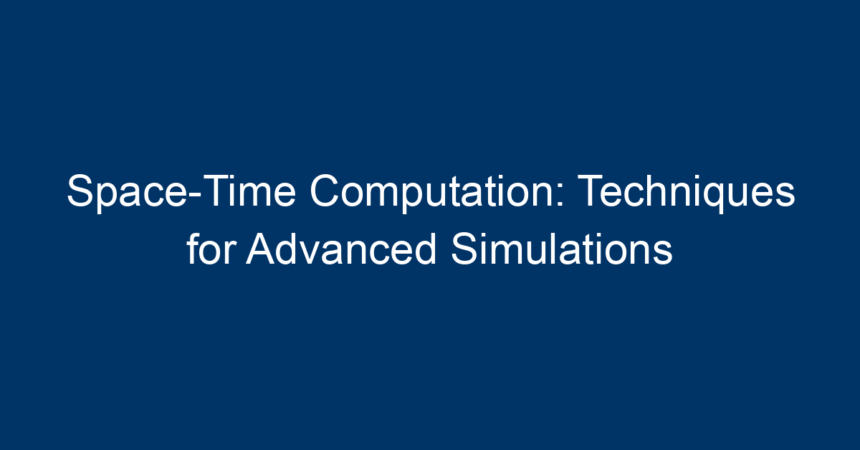Introduction
In recent years, the field of computational science has evolved dramatically, pushing the boundaries of how we understand and simulate complex systems. One of the most groundbreaking advancements is in space-time computation, which integrates both spatial and temporal dimensions for advanced simulations. This approach not only enhances accuracy but also allows researchers to model dynamic systems more intuitively. As we venture deeper into topics such as climate modeling, astrophysics, and quantum mechanics, the techniques of space-time computation become increasingly essential. In this article, we will explore the various techniques used in space-time computation, their applications in different fields, and how these methods can pave the way for future innovations.
What is Space-Time Computation?
Definition and Concept
Space-time computation is an innovative framework that addresses both space and time as critical dimensions in computational models. By treating time as a continuous variable tied to spatial variables, these computation techniques facilitate a deeper understanding of dynamic phenomena. This allows scientists to simulate scenarios where both space and time interact, resulting in more accurate representations of reality.
Historical Context
The roots of space-time computation can be traced back to theoretical physics, particularly in the field of relativity where space and time are interwoven. Over the decades, advancements in computational power and algorithms have made it feasible to apply these theoretical concepts in practical simulations. Modern computational techniques, such as finite element analysis and agent-based modeling, have further expanded the possibilities in space-time computation.
Techniques in Space-Time Computation
1. Finite Element Method (FEM)
The Finite Element Method (FEM) is one of the most widely used techniques in space-time computation. It breaks down complex structures into smaller, manageable pieces or "elements." Each element can be analyzed separately and then combined to understand the overall behavior of the structure.
- Application: FEM is particularly useful in engineering fields for structural analysis, heat transfer, and fluid dynamics. By integrating time as a variable, engineers can simulate how materials behave under various conditions over time.
2. Lattice Quantum Field Theory
In theoretical physics, Lattice Quantum Field Theory (LQFT) provides a method to compute quantum field theories by discretizing space-time into a lattice structure. This approach is essential for studying particle physics and understanding fundamental forces.
- Benefits: LQFT allows for non-perturbative calculations that can yield insights into the behavior of particles at high energies, making it invaluable in the realm of subatomic particle research.
3. Computational Fluid Dynamics (CFD)
Computational Fluid Dynamics involves the numerical analysis of fluid flows and is heavily reliant on space-time computation techniques. By modeling the behavior of fluids over both time and space, engineers can simulate everything from airplane aerodynamics to weather patterns.
- Real-World Use: CFD is crucial in designing efficient vehicles, predicting weather phenomena, and even simulating ocean currents in climate models.
4. Agent-Based Modeling
Agent-Based Modeling (ABM) focuses on individual entities (agents) and their interactions within a defined environment over time. This technique allows researchers to simulate complex behaviors that emerge from the interactions among agents.
- Case Studies: ABM is used in economics, ecology, and social sciences to study phenomena such as traffic patterns, disease spread, and market dynamics.
5. Time-Dependent Partial Differential Equations (PDEs)
At the heart of many space-time computation techniques are time-dependent partial differential equations (PDEs). These equations describe how physical quantities evolve over space and time, making them crucial for modeling dynamic systems.
- Applications: Time-dependent PDEs are integral to simulations in physics, engineering, and finance, capturing the evolution of systems over time.
Applications of Space-Time Computation
1. Climate Modeling
One of the most impactful applications of space-time computation is in climate modeling. By simulating atmospheric conditions over time and space, scientists can predict climate change impacts and devise strategies for mitigation.
- Techniques Used: Climate models often involve a complex interplay of FEM, CFD, and time-dependent PDEs to produce insightful predictions.
2. Astrophysics
In astrophysics, space-time computation assists in the simulation of celestial events such as supernovas, black holes, and galaxy formation. The interactions between various cosmic entities are best understood using advanced computational techniques that incorporate both time and space.
- Insight Gain: These models provide critical insights into the dynamics of our universe, contributing to our understanding of fundamental cosmological phenomena.
3. Biomedical Simulations
Space-time computation has also entered the field of biomedical engineering. Techniques like ABM and FEM are used to simulate biological processes, ranging from drug delivery systems to the behavior of tissues under stress.
- Impact on Healthcare: Such simulations can lead to more effective medical treatments and interventions, ultimately improving patient care.
4. Urban Planning
Urban planners utilize space-time computation to model and analyze the dynamics of city growth and development. By simulating various scenarios, planners can make informed decisions that promote sustainable urban environments.
- Implementation: Techniques like agent-based modeling are often employed to understand human behavior, traffic flows, and resource allocation within urban settings.
Future Directions in Space-Time Computation
As computational resources continue to expand, the capabilities of space-time computation will also increase. Here are a few potential future directions:
-
Artificial Intelligence Integration: Combining AI with space-time computation could enhance predictive modeling, allowing simulations to adapt and improve over time based on real-world data.
-
Quantum Computing: The advent of quantum computing may revolutionize space-time simulations, providing unprecedented processing power that could solve complex equations much faster than current classical methods.
- Interdisciplinary Applications: As the methods and techniques of space-time computation become more refined, their applications will likely extend beyond traditional fields. Emerging areas such as smart cities, autonomous vehicles, and climate engineering could benefit significantly.
Conclusion
Space-time computation is reshaping how we approach complex simulations across various fields, from climate science to biomedical engineering. By leveraging a range of techniques—such as finite element methods, lattice quantum field theory, and agent-based modeling—researchers can create more accurate and insightful simulations. As technology continues to evolve, the scope and potential of space-time computation will only expand, offering new solutions to some of the most pressing challenges facing our world.
Investing in knowledge, tools, and training related to space-time computation can provide significant benefits for professionals in science, engineering, and beyond. For anyone interested in harnessing the power of advanced simulations, engaging with these techniques is a step toward the future. Whether you’re a researcher, engineer, or student, exploring the vast potential of space-time computation is crucial for driving innovation in your field.




